Timber rafting
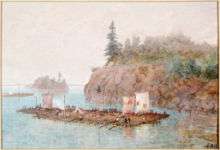
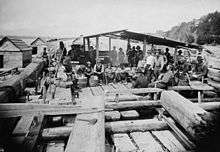

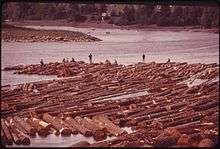
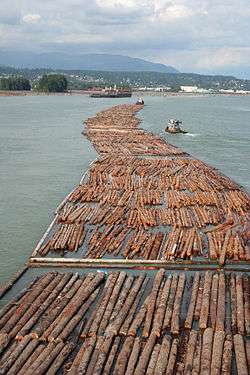
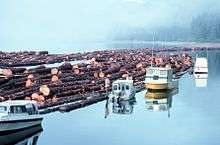
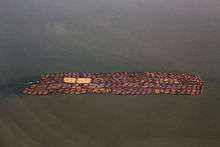
Timber rafting is a log transportation method in which logs are tied together into rafts and drifted or pulled across a water body or down a flatter river. It is arguably the second cheapest method of transportation of timber, next after log driving. Both methods may be referred to as timber floating.
Historical rafting
Unlike log driving, which was a dangerous task of floating separate logs, floaters or raftsmen could enjoy relative comfort of navigation, with cabins built on rafts, steering by means of oars and possibility to make stops. On the other hand, rafting requires wider waterflows.
Timber rafts were also used as a means of transportation of people and goods, both raw materials (ore, fur, game) and man-made.
Theophrastus (Hist. Plant. 5.8.2) records how the Romans imported Corsican timber by way of a huge raft propelled by as many as fifty masts and sails.[1]
This practice used to be common in many parts of the world, especially North America and on all main rivers of Germany. Timber rafting allowed for connecting large continental forests, as in south western Germany, via Main, Neckar, Danube and Rhine with the coastal cities and states, early modern forestry and remote trading were closely connected. Large pines in the black forest were called „Holländer“, as they were traded to the Netherlands. Large timber rafts on the Rhine were 200 to 400m in length, 40m wide and consisted of several thousand logs. The crew consisted of 400 to 500 men, including shelter, bakeries, ovens and livestock stables.[2] Timber rafting infrastructure allowed for large interconnected networks all over continental Europe. The advent of the railroad, steam boat vessels and improvements in trucking and road networks gradually reduced the use of timber rafts. It is still of importance in Finland.
Construction
Timber rafts could be of enormous proportions, sometimes up to 600 metres (2000 ft) long, 50 meters (165 ft) wide, and stacked 2 metres (6.5 ft) high. Such rafts would contain thousands of logs. For the comfort of the raftsmen - which could number up to 500 - logs were also used to build cabins and galleys. Control of the raft was done by oars and later on by tugboats.
Raft construction differs depending on the watercourse. Rocky and windy rivers saw rafts of simple, yet sometimes smart, construction. For example, the front parts of the logs were joined together by wooden bars, while the rear parts were loosely roped together. The resulting slack allowed for easy adaptation for narrow and windy waterbeds. Wide and quiet rivers, like the Mississippi River, allowed huge rafts to travel in caravans and even be chained into strings.
Timber rafting in the southeastern United States
Rafting was a principal method of transporting timber in the southeastern United States but, except on the Mississippi River, rafts were necessarily smaller than those described above. On Georgia’s Altamaha River, for example, the maximum width was about forty feet (12 m), that being the widest that could pass between the pilings of railroad bridges. Maximum length was about 250 feet (76 m), that being the longest that could navigate The Narrows, several miles of the river that were not only very narrow but also very crooked. Each raft had two oars forty to fifty feet long, one in the bow, the other at the stern. The oars were for steering, not propelling, the raft. The minimum raft crew was two men, the pilot who usually manned the stern oar, and his bow hand. Rafts usually had a lean-to shack for shelter and a mound of dirt for a hearth to warm by and cook on.
Most rafts were sharp-chute, that is, V-bowed, rather than square-bowed. Raftsmen had learned that with a V-bow a raft was more likely to hold together and glance off if it drifted out of control and hit the river bank. As one old-time raftsman put it: “With a square bow you were compelled to hold the raft in or near the middle of the river: if it butted the hill it would come to pieces. The sharp-chute could be put together so it would not come apart. And it saved a lot of hard work. Raftsmen didn’t mind letting it go to the hill. They’d say: ‘Let’er shoot out.’”
Rafts were assembled in sections. Each section was made up of round or squared timbers, all of the same length except for the outside, or “boom logs,” which extended aft a few feet to enclose the following section. Thus the sections were coupled together. A fairly typical raft would be one of three, four or five sections, each section having timbers twenty to thirty feet in length.
Most rafts were made up of squared timbers, either hewn square by hand or sawn square by upcountry sawmills. Some timbers were carefully, smoothly hewn, and there was a demand for them, especially in England, after steam sawmilling became common. On the Altamaha, for many years during the rafting era, most rafts were made up of “scab” timber, that is, logs roughly squared by broad ax for tighter assembly and for gang sawmills which could cut flat-face timber only.
Although, on the Altamaha, there was rafting to some extent before the Civil War and after World War I, the Altamaha’s rafting era is generally considered to have been the years between those wars. During those years, Darien, a town at the mouth of the river with a population of perhaps a couple of thousand, was a major international timber port. Reports of exports from Darien were included in the New York Lumber Trade Journal along with reports of exports from such large ports as New Orleans, Mobile, Jacksonville, Savannah, Charleston, and Norfolk.
As the era of rafting receded into the past, old men recalling old times on the river talked so much about how boisterous some raftsmen were, about how ready they were for fight or frolic and, whichever, the rougher the better, and about the pranks they pulled and yarns they told—as to give the impression that that’s the way most all raftsmen were. It was a wrong impression, of course. Even so, old timers perpetuated it because in describing river life years later they tended to romanticize it—which is not surprising since they had found on the river and in Darien more than a way to make a little money, they had found a way to escape the drudgery and monotony of life in the backwoods.
“When I was told, ‘Go to Darien,’ I was ready! one old-timer recalled. His sentiment was typical. In Darien raftsmen saw a world far different from the drab upcountry. They saw miles of log booms and, out toward the ocean, the rigging of towering sailing vessels or the stacks of steamships. In town they mingled with sailors from many countries speaking strange languages. If in Darien for the first time, local historian Bessie Lewis said, they stared at the sights “with concealed amazement,” then went back home to recount with exaggeration their adventures.
Talking about old river days raftsmen always mentioned Rag Point. Anyone aboard coming down-river for the first time was required to “treat” the point by placing an item of wearing apparel upon it. The penalty for refusal was to be “ducked or docked”—ducked in the river or docked for drinks in the saloons of Darien.
Old-timers also always mentioned the river “holler,” a kind of yodel a raftsman would sing out early of a morning or late of an evening. It would echo up and down the river and, momentarily, another raftsman’s lonesome response would come echoing back.
Well into the 1900s long after Native Americans no longer occupied the lands to the west and south of the river, they always mentioned the custom of referring to the river banks as “white” and “Indian,” or as the raftsmen usually pronounced it, “Injun.” “Ease the bow to Injun” was a typical command of a raft pilot to his bow hand.
See also
- Benson raft
- Timber slide
- Log flume
- Eight Hundred Leagues on the Amazon, novel by Jules Verne about a timber raft trip down the Amazon River.
- Wood economy
References
- ↑ Casson, Lionel (1995): "Ships and Seamanship in the Ancient World", Johns Hopkins University Press, ISBN 978-0-8018-5130-8, p. 4, fn. 2
- ↑ Beschreibung eines großen Rheinfloßes
Further reading
- Bowering, Ian How timber rafts ran the Long Sault rapids in Standard Freeholder (October 8, 1993) accessed at Cornwall Public Library, Ontario June 21, 2006
- Morrison, Carlton A. Running the River: Poleboats, Steamboats & Timber Rafts on the Altamaha, Ocmulgee, Oconee & Ohoopee.Available in various Georgia (U. S.) libraries and from the publisher's website:' 'www.saltmarshpress.com
External links
![]() Media related to Timber floating at Wikimedia Commons
Media related to Timber floating at Wikimedia Commons
- International Timber-Raftsmen Association with member organizations in 11 countries